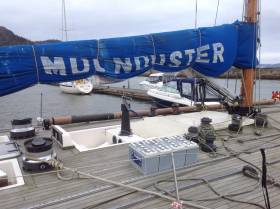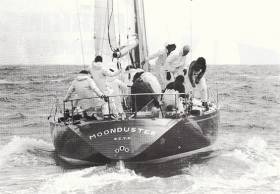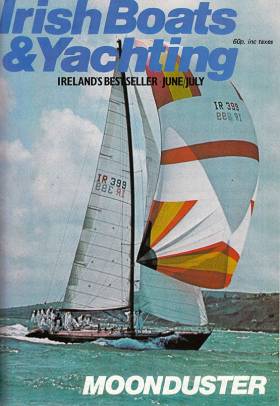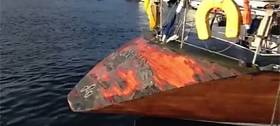Displaying items by tag: Moonduster
Will Ireland’s Legendary Moonduster Just Moulder Away?
As each year passes, it becomes increasingly difficult to explain to up-and-coming offshore racers just what “The Doyler and The Duster” meant to a whole generation of Irish sailors writes W M Nixon.
Crosshaven-built in 1981 and kitted out with sails from the new McWilliam loft just up the road, the majestic Moonduster was a one-off Frers 51 sloop which was our flagship, while the ever-enthusiastic Denis Doyle was our captain, our admiral, the great skipper who always went the extra mile – indeed, the extra thousand miles and more - to sail and race for Ireland, leading by example and winning many trophies along the way.
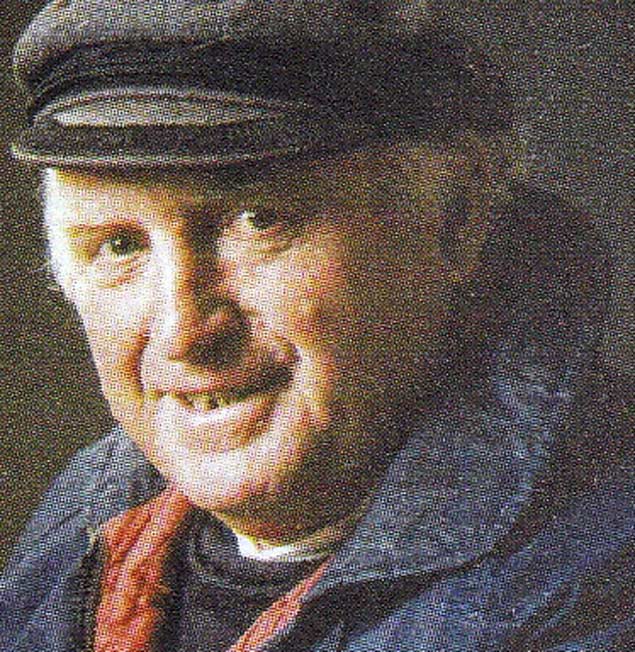 Denis Doyle, the inspiration for more than one generation of Irish offshore sailors.
Denis Doyle, the inspiration for more than one generation of Irish offshore sailors.
When he died in the Autumn of 2001 – having completed his last Fastnet aboard Moonduster at the age of 81 back in August – it left a void, an empty gap so great that no-one really comprehended its enormity at the time. Yet as the months passed, it became clear that nobody in Ireland could reasonably be expected to take over Moonduster and everything which that entailed, for the pace and dedication with which Denis Doyle campaigned Moonduster – supported by his indomitable wife Mary – was far beyond the capacities of even the most talented Irish skipper.
So when in due course Moonduster was sold away to a new project for an offshore sailing school based in Trondheim well north along the coast of Norway, it was a relief in Crosshaven and throughout Ireland. The splendid yacht seemed to have found a new purpose in life which – if done properly – was worthy of her. And for a while all seemed well, with the occasional photo circulating of Moonduster fulfilling her new role off the mountainous Norwegian coast with that same unmistakable style.
 Moonduster in action off Trondheim during her early years in Norway
Moonduster in action off Trondheim during her early years in Norway
Few - if any - remember precisely when there started to be disturbing hints that all was not well in Trondheim. A boatyard fire destroyed another substantial offshore racer belonging to the school, but the word was that Moonduster was safe. There was silence for a while, then two or three or maybe more years later, photos came back showing Moonduster still in Trondheim, but now in a neglected and unused state.
However, there were hopeful hints that a syndicate of concerned former Moonduster sailors was being assembled to remedy the situation. Yet nothing seems to have come of it, for her ownership is an increasingly complicated matter. And then at the end of June this year an email arrived from Mike Foreman, who was cruising in Norway with his Nich 35 Blue Tarn, and in Trondheim he had happened – with some shock – on Moonduster in woeful condition against a rather insalubrious quayside in a corner of the harbour.
 Moonduster glimpsed from a distance in Trondheim at the end of June. Photo Michael Foreman
Moonduster glimpsed from a distance in Trondheim at the end of June. Photo Michael Foreman
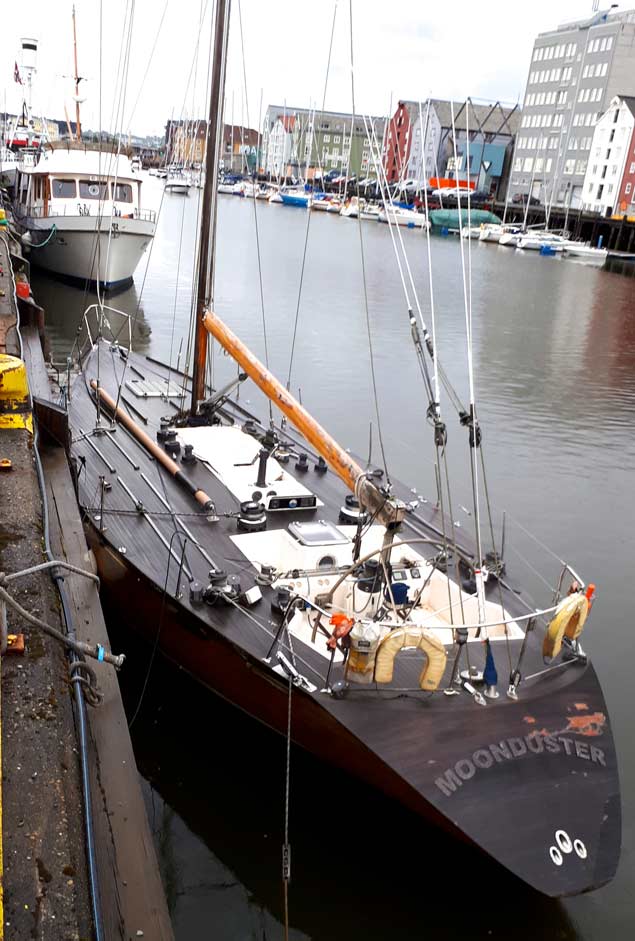 Only a ghost of her former herself – were it not for the name on the transom, we’d hardly recognize her. Photo: Michael Foreman
Only a ghost of her former herself – were it not for the name on the transom, we’d hardly recognize her. Photo: Michael Foreman Moonduster, Trondheim, June 2019 – somewhere in there is one of the most sophisticated examples of wooden boat construction ever built in Ireland. Photo: Michael Foreman
Moonduster, Trondheim, June 2019 – somewhere in there is one of the most sophisticated examples of wooden boat construction ever built in Ireland. Photo: Michael Foreman
Mike Foreman spent his boyhood on the shores of Ballyholme Bay on Belfast Lough, as I did too. But while I simply wanted to mess about in boats for sport in cruising and racing, he seriously wished to become a professional fisherman and ended up based in Carradale in western Scotland, an attractive little fishing port about halfway up Kilbrannan Sound inside Arran, on the Kintyre coast.
There, he was owner-skipper of three fishing boats in succession, the middle one being the 1957-built 56ft Glendalough from Tyrrell of Arklow, which was in Portavogie ownership by the time he bought her in the early 1980s.
 The 56ft Glendalough, built by Tyrrell of Arklow in 1957, which Michael Foreman fished from Carradale for five years in the 1980s
The 56ft Glendalough, built by Tyrrell of Arklow in 1957, which Michael Foreman fished from Carradale for five years in the 1980s
He fished west of Kintyre and around Gigha in summer, and up the Clyde in winter, mostly at night past Rothesay and beyond. It’s thought-provoking to think of the yacht-owning burghers of Largs comfortable in their beds of a January night as this Ballyholme boy went slowly past their darkened windows, out in the Firth in the deep cold of winter in search of a good catch….
Tough it may have been at times, sometimes very tough, but he never lost his love of seafaring, and when he retired from the fishing he bought himself a 28ft Twister class sloop for a spot of summer cruising, and then followed her with the Nicholson 35 Blue Tarn, with which he did an Atlantic circuit cruise in 2008-2009.
 Mike Foreman’s Nich 35 Blue Tarn off Bequia in the Caribbean in 2009
Mike Foreman’s Nich 35 Blue Tarn off Bequia in the Caribbean in 2009
It was while cruising Blue Tarn towards the Lofoten Isles in Arctic Norway this past summer that he put into Trondheim in search of a replacement part for a broken section of his wind-vane. It emerged that its delivery would take all of six days, so he got to know Trondheim rather better than he would have liked, for it rained every day. But in one of his walks around the town and harbour, he came upon Moonduster, and she’s not a welcome sight for anyone who cares as much about boats as Mike Foreman.
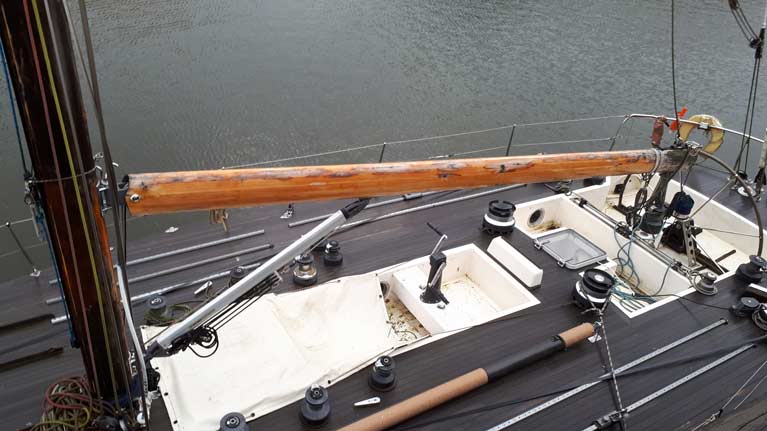 Moonduster 2019 – a sad state of affairs. Photo: Michael Foreman
Moonduster 2019 – a sad state of affairs. Photo: Michael Foreman
The thought of the images he sent was pushed to the back of the mind while we went through the busy season of 2019. But now here we are, nearly three months later, and if there’s any word on the grapevine about hopeful news of Moonduster, it certainly hasn’t percolated through to those who would know in Crosshaven.
Mike Foreman’s photos speak for themselves. Moonduster needs something to be done, but the estimate from a highly qualified expert who knew her well says that we’re talking about a project of at least €0.5 million. And when you have restored her, what will you do with her?
As the restored Ilen of Limerick has shown, such projects need a purpose beyond simply restoring them to seagoing conditions. Thus Ilen’s cultural-exchange Salmons Wake voyage to Greenland and her subsequent work in the Sailing into Wellness programme in Kinsale add an extra valuable and meaningful dimension to her new way of life.
 Historic boats with a new purpose in life – Ilen and Killary Flyer in Nuuk in Greenland in August, Paddy Barry on Ilen (far left), Jamie Young on bow of Killary Flyer (right)
Historic boats with a new purpose in life – Ilen and Killary Flyer in Nuuk in Greenland in August, Paddy Barry on Ilen (far left), Jamie Young on bow of Killary Flyer (right)
And ironically, it was while she was in Greenland that Ilen met up with another Irish-based boat which, like Moonduster, is a former top-line international offshore racer. This was Jamie Young’s Frers 49 Killary Flyer from the Killary Adventure Centre in Connacht, a boat which - as Hesperia and before that as Noryema IX - was very much a successful fixture on the national and international racing scene.
But Killary Flyer is built of aluminium alloy, which means she can confidently go into the ice, and every year she spends prolonged periods in Greenland waters on expedition voyages – so much so that this year we secretly expected her to become the first yacht to circumnavigate Greenland as the ice recedes, but it seems that’s something for another year, as she was southward bound when Ilen met her in Nuuk.
In contrast to Killary Flyer’s robust alloy hull, Moonduster is timber finished in multi-skin mahogany using the WEST system. Superbly strong, but definitely not suitable for ice-bashing. Nevertheless Moonduster’s construction – with Dick Leonard in charge on the build floor in Crosshaven Boatyard and Tony Castro project managing to report to all concerned – was quite something, as her two wafer-like inner diagonal skins were mahogany, then she’d a skin of carbon, then she’d two more diagonal skins of mahogany, then another skin of carbon, and then two final skins of mahogany, the outer one being horizontal.
It sounds as if it might have been ultimately quite heavy, yet on the contrary, it was exceptionally light. So much so, in fact, that on the night before the first Admirals Cup Selection Trials Race in mid-May 1981, Tony Castro, Dick Leonard, The Doyler himself and others were sweating in the bilges of Moonduster trying to get enough lead in place to bring her rating down to the AC maximum of 40ft while still complying with all RORC and measurement rules requirements. They finally succeed a few minutes after 2200 hrs, and next morning Moonduster made her racing debut in that glorious style which imprinted itself on Irish sailing consciousness for two wonderful decades.
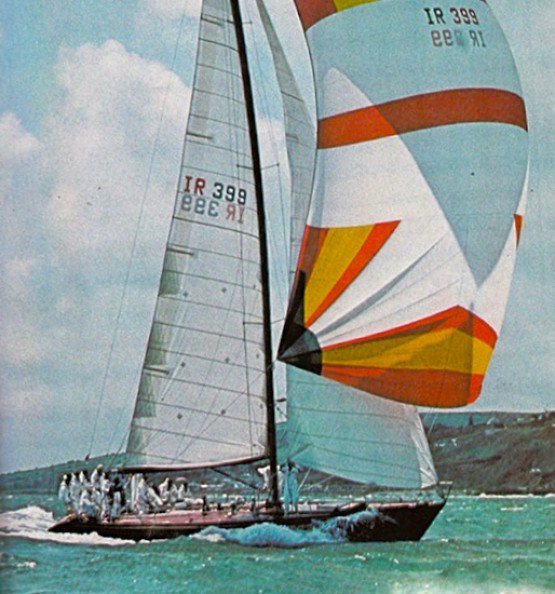 Moonduster makes her racing debut in May 1981. Photo: W M Nixon
Moonduster makes her racing debut in May 1981. Photo: W M Nixon
So now what’s to be done? I simply don’t know. Perhaps there has been a miracle in Trondheim since June that no-one has yet heard about. We can only hope that something good happens, for 1981 was a very special year for maritime Ireland. The new Asgard II was commissioned for the first time in March 1981. And then Moonduster made her debut in May. It would be very sad if we were to lose both of them.
Moonduster Looking Sad This Morning In Trondheim, Meeting About Her Future In Royal Cork Yacht Club This Evening At 7pm
The great Denis Doyle’s star-quality Frers 51 Moonduster of 1981 vintage, built in Crosshaven Boatyard with the legendary Dick Leonard in charge of the construction details and the then-locally-based designer Tony Castro as consultant, is in a sorry state in Trondheim in Norway. This has been her home port since she was sold there in 2005 following The Doyler’s death in the Autumn 2001, after he’d sailed his last Fastnet Race aboard her that summer aged 81 writes W M Nixon
The condition of the iconic Moonduster has recently been a topic of busy conversations on Afloat.ie, and this evening in the Upstairs Bar of the Royal Cork Yacht Club at Crosshaven, an exploratory open meeting will be held at 7.0pm to gauge the level of interest in this very special boat, and hear opinions about what best can be done about her future.
As it happens, leading Crosshaven sailing couple Brian and Eleanor Cudmore overnighted in Trondheim last night while on a Hurtigurten ship cruise to the far north along the Norwegian coast. This morning before sailing they made a point of returning to Monduster (which they’d seen in the dark yesterday) to send us these up-to-date photos of the state of a still-great yacht, albeit one that has fallen in hard times.
In the last analysis, much will depend on a proper survey. But nevertheless from these photos she looks to be eminently restorable to her former stylish glory, though where there has been a small hull puncture – as in the starboard side – it will take a good eye and experience of how varnished wood changes colour to properly match in any new timber required.
Read also: Why Moonduster Should Not Make Ireland Her Home After Restoration
Hello and welcome aboard this week’s edition of your maritime programme Seascapes .....this week we hear about efforts afoot to assist in the restoration of “Moonduster”; we have the results of our recent competition for copies of Carsten Kriegers ‘ “This Is the Burren” courtesy of The Collins Press ; we talk to Donal Boland whom we met last weekend in Athlone whilst we were at The Dive Ireland Conference about a gathering in Lynches of Tullamore this weekend focussing on The Mid Shannon with a wide range of speakers; how the British Ambassador to Ireland HE Mr Dominick Chilcott earlier this week paid homage to Sir Ernest Shackleton and members of the Imperial Trans Antarctic Expedition and the Centenary of their return home with Tom Crean and our many maritime heroes celebrated by author Michael Smith who addressed the large gathering in the Ambassadors’ residence with descendants of the Shackleton and Crean families present, the Shackleton Mueseum in Athy and all branches of the forces including Chief of Staff of The Defence Forces – Vice Admiral Mark Mellett just returned from Mali..... ....first this week to last weekend’s Skipper Expo in Galway – Seascapes was there on Saturday where we met many regular listeners and contributors – one man whom I remember reading as a young boy was there, the veteran journalist and founding editor of The Skipper now in his eighties Arthur Reynolds had this to say....
Read also WM Nixon: Why Moonduster Should Not Make Ireland Her Home After Restoration
This week’s sad video on Afloat.ie about the dilapidated and deteriorating condition of the late Denis Doyle of Cork’s very special Frers 51 Moonduster in northern Norway has led to a flurry of communication on social media, and all sorts of suggestions about how best she might be restored and used in the future. Inevitably, there have been many who reckon she should find her future back home in Ireland, and be properly restored here. W M Nixon isn’t so sure.
There was a period recently when the word “iconic” appeared so frequently as to become meaningless. But fortunately we’ve moved on from that level of gross over-use, and a certain rigour has returned to the deployment of this very useful and eloquent adjective. Which is just as well, for when you try to tell today’s rising generation of offshore sailors just what Denis Doyle and Moonduster meant to us during their twenty years of glory from 1981 to 2001, “iconic” and “inspirational” are the only words which will hit the target.
In fact, the complete force was a threesome, as it was Denis Doyle and his wonderful and supportive wife Mary (nee Woodward) and Moonduster. But even when Mary had passed on in 1993, such was the strength of the team inspired by them that Denis and Moonduster continued actively campaigning at home and abroad with the support of an army of friends. He did his final Fastnet Race with Moonduster in 2001 aged 81, and was gone from among us by the Autumn.
To say that Moonduster looked forlorn in the big shed in the winter of 1981-82 at Crosshaven Boatyard where she had been built is scarcely to begin to grasp just what “The Doyler and The Duster” had meant to Cork and to Irish sailing and to world offshore racing. They represented a level of commitment to the sport and to the communities it involved which few other people-and-boat combinations could match.
Awareness of this first came to me this in Cowes in the summer of 1969, when we’d taken a 35ft boat we built in Carrickmacross (as one does) down south to do Cowes Week and the Fastnet Race. We seemed to spend a lot of time in Groves & Guttridge’s yard with much hammering being heard from within our County Monaghan boat, and our only consolation was that there was even heavier hammering coming from within Dick Carter’s innovative Red Rooster beside us on the hard, with her huge lifting keel continuing to give problems.
Subsequently, Red Roooster went on to win overall in the Fastnet, while we with our very homemade boat were 122nd out of 250 entries - it truly took a helluva lot of boats to beat us. Yet it takes an effort to remember all that. But what I do remember vividly is a little exchange on the balcony of the Island Sailing Club where I was taking a break from the boatyard mayhem and maybe enjoying a beer or three, and certainly a breath of fresh air in the sunshine, as the last of the fleet from that day’s New York Yacht Club Cup race came into port.
Conspicuous among them was Denis Doyle’s first Moonduster, the very handsome Robert Clark-designed white 47–footer built in Crosshaven Boatyard in 1965. Moonduster was particularly conspicuous because, unlike the other boats coming up the Medina River under engine, she was being sailed by Denis with consummate skill, for he disdained to have an auxiliary engine, as had also been the case with his first Crosshaven-built Robert Clark offshore racer, the 38ft Querida of 1963.
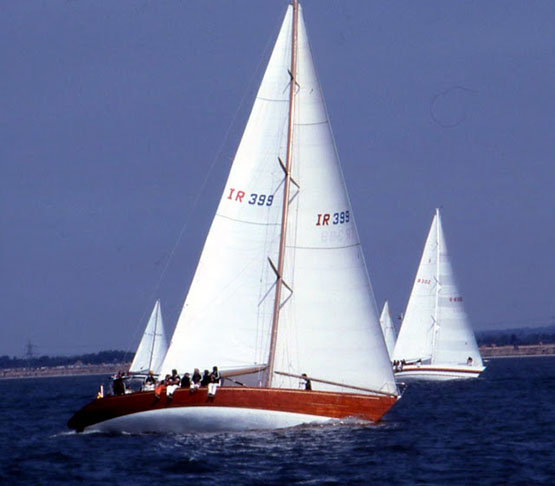
The Solent was only one of many venues to which Denis & Mary Doyle & Moonduster gave total commitment. This is the new Moonduster racing in the Admirals Cup of 1981.
Foolishly, I made some quip about the mad Doyler and his engine-less boat to a formidable matron who was beside me in the balcony crowd. She put me very firmly in my place. It emerged she was Denis and Mary’s Cowes landlady, and she was on the balcony to see her hero sail into port. It seemed that, ever since Denis and Mary and whatever boat they happened to be campaigning that year had been coming to Cowes, after careful research they’d selected this woman’s Bed & Breakfast to be their Cowes base. And they had stayed loyally and on the best of terms with her ever since. In the hierarchy of Cowes landladies, this put her very high up the pecking order.
“If a few more of these supposed gentlemen yachtsmen coming to Cowes Week brought the same sense and level of support, respect, generosity, consideration and kindness to the local folk as Mr & Mrs Doyle do, then Cowes would be a much more prosperous and happy little town” I was crisply informed.
You remember little exchanges like that long after numerous Cowes Weeks and three Fastnet Races have become a hazy memory. And the sign-off line was the killer punch. “On top of their friendliness, after Mary has seen Denis off in the Fastnet Race or whatever race is taking Moonduster away from Cowes, she’ll always drop by to say goodbye until next time, and present me with a lovely bouquet of flowers”.
The Doyler’s boat-owning history was fascinating. His first higher- visbility campaigning was with a Cork Harbour OD, but then for a while he took his first serious steps offshore with the converted 6 Metre Vaara. But it was with the 30 Square Metre Vanja IV – which he bought from Lough Derg – that he began to do more serious offshore stuff verging on into RORC events, which he continued with the “Straight Eight” Severn II, one of a group of impressive International 8 Metres which set the tone in Crosshaven in the 1950s and 60s.
However, having bought Crosshaven Boatyard to add to his extensive maritime business portfolio, he linked up with that noted designer of elegant offshore racers Robert Clark to build the 38ft Querida in 1963, and the much-loved 47ft white Moonduster (named after a racehorse) in 1965, with the link-up reaching a peak with Francis Chichester’s last boat, the Clark-designed Gypsy Moth V, in 1970.
As for Denis Doyle, the white Moonduster was succeeded in 1973 by the blue Moonduster, a massively powerful 47ft Sparkman & Stephens design which, alas, came to an unhappy end in the Pacific some years ago. But Denis Doyle had long since moved on, for after her for two or three years he had a fibreglass Ron Holland-designed Swan 44, a standard boat which couldn’t quite compete with one-offs, yet she was the only member of the Irish Admirals Cup Team of 1979 which managed to finish the disastrously storm-tossed Fastnet Race of that year.
But by 1980 The Doyler’s heart was set on a new Frers 51-footer which was to be wooden built multi-skinned in Crosshaven Boatyard. She was the absolute essence of Frers in style and appearance, yet the name Moonduster appears only once in an offhand sort of reference in the official Frers book, A Passion for Design. For if memory serves aright, German Frers allowed Dick Leonard of Crosshaven Boatyard access to the lines of the hugely successful alloy-built Frers 51 footer Blizzard, and Dick went to work and developed the detailed plans for wooden construction while the young up-and-coming Crosshaven designer Tony Castro was called in as consultant when added expert help was needed.
Thus Moonduster may have been Frers without, but she was pure Crosshaven within. And my goodness, but she was good-looking. When she first appeared in the nick of time for the Irish Admirals Cup trials in May 1981, you didn’t really look at any other boat. An elegantly varnished hull with effortlessly powerful performance, this new Moonduster was a yacht as yachts should be.
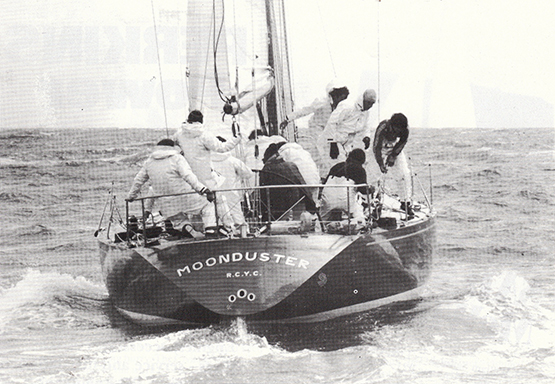
“An elegantly varnished hull with effortlessly powerful performance…..” Moonduster off Cork in May 1981. Photo: W M Nixon

“There was only one boat to look at”. Moonduster leading the fleet in the 1981 trials. Photo: W M Nixon
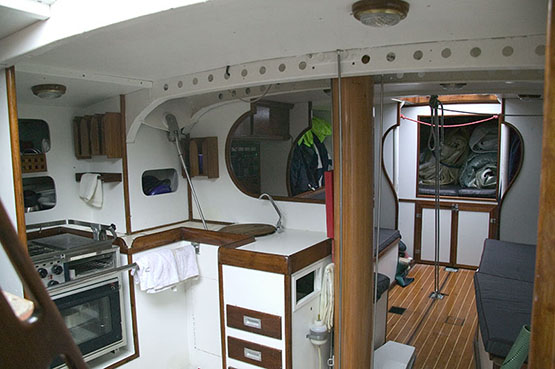
Moonduster’s interior is functional yet attractive
And though in some sense she may have been “unofficial Frers”, all I know is that a few month after her successful first season, when the 1982 Falklands War was under way I received a circuitous request from Buenos Aires for a print suitable for framing and wall-hanging of that photo of mine which appeared in the poorly-printed cover of the June/July 1981 Irish Boats & Yachting, one of the incarnations of Afloat. In due course, the carefully rolled and packaged print found its way past the war and on into Argentina and the Frers establishment, where presumably it joined the wall display among other classic Frers designs where Moonduster so rightly belonged.
But getting the photo to Mr Frers was only the beginning of The Last Moonduster Story. In 1982 Denis and Mary and Moonduster committed themselves to the Round Ireland Race and Wicklow with the same devotion that they gave to the Fastnet Race and Cowes in alternate years, and it was the making of the event, with Moonduster establishing a good record in 1982, and then an incredibly good Round Ireland record in 1984 which stood for many years.

The beginnning of a great relationship – Moonduster approaching Wicklow for the finish of the Round Ireland Race of 1982.

“The gang’s all here”. Moonduster on the way to her enduring Round Ireland record in the race of 1984, with Neil Hegarty on the helm (left), Donal McClement on the mainsheet, Brendan Fogarty (foreground), Davy Harte, and the late Grattan Roberts.
But involvement with Wicklow and Cowes at the appropriate times was only part of the Moonduster mystique. Another indirect Moonduster recollection that springs to mind is of stepping in to the Club Nautico de Montereale or whatever it’s called in Bayona in northwest Spain in 1995 after sailing out from Ireland across Biscay, and there was the Commodore honours board and beside it the honorary members list, and the top of the latter was one King Juan Carlos and beside him was Denis N Doyle. Moonduster enjoyed bringing a bit of real style to the scene in northwest Spain, while Juan Carlos was an old friend from the Admirals Cup years of the mid-70s, and they partied mightily when he came aboard Moonduster at Cabrera when the Irish boat was on her way to the Sardinia Cup at Costa Smeralda.
But whoever it was, king or crewman, Denis was the same utterly straight Denis Doyle. Photographers tried to capture the spirit of this very remarkable man, but it was impossible to get the essence of his character, for without being a fidget in any way, he was a man of action, and his character was most purely expressed through what he did.

Even the best photographers had difficulty in capturing the essence of Denis Doyle in a portrait, for he was what he did. Photo courtesy RCYC
So when he died, it was only natural that nobody in Cork or Ireland wanted to take on Moonduster. It was a great relief when eventually she was sold to Trondheim far in the north of Norway for a sail training school, for in some ways that was what she had been in the Doyle ownership, with his great shipmate Colonel Barney Goulding introducing platoons of young soliders who became great crewmen, for unlike navy cadets, they didn’t come aboard with any preconceived notion of how a boat should be sailed and run.
But now the care of Moonduster in Norway has apparently gone pear-shaped and beyond. A saviour and guardian angel is urgently required. And if you insist and can organise it, by all means get her restored to full health in Ireland. But once that’s done, please take her away to join the classic offshore racers group in the Mediterranean. Take her away and keep her away for a good while yet. Fifteen years may have passed. But we’re still not ready to see Moonduster sailing in Ireland again without The Doyler at the helm.

In her early days in Norway, Moonduster seemed to have settled well in her new home
Queen of Irish Yachting Moonduster is 'Sad Sight' in Norway
There has been plenty of comment on social media about the current condition of the much loved Irish yacht Moonduster, the former Round Ireland record holder skippered by the late Denis Doyle of the Royal Cork Yacht Club. See the full video below.
'Sad to see this. Many happy hours on that beautiful vessel in and out of Cork Harbour', says Stu McLoughlin echoing many similar comments about the state of the one time pristine Frers 51 that was the pride of the Irish fleet in the 1980s.
Sad to see Moonduster looking like this!
Posted by SailCork.com on Saturday, 27 February 2016
Doyle owned four different Moondusters in his long career. His last boat, arguably the best known, the varnished Frers, was sold to Norway around 2005 where she is still sailing but as can be seen in the photographs not in the same state of repair as she had been in Crosshaven.
'...She's in a shocking state, clearly her current and previous owners never cared too much about her. However, she's still salvageable but for how much longer? says Mark Richards on Facebook.
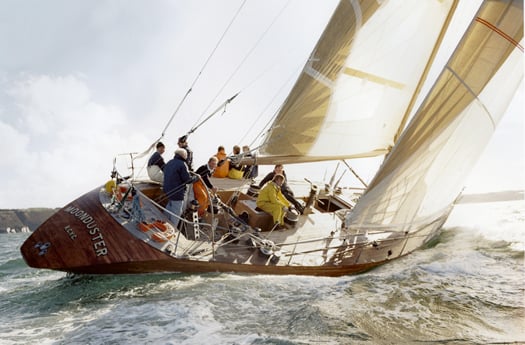
The queen of all fleets. Denis Doyle's legendary Moonduster was the flagship of Irish offshore racing for twenty years. Readers will recall Bob Bateman's 1988 classic photograph of Doyle at the helm. Doyle's enthusiastic support moved the Round Ireland Race into the international league, and his regular participation set performance standards which greatly enhanced the event.




























